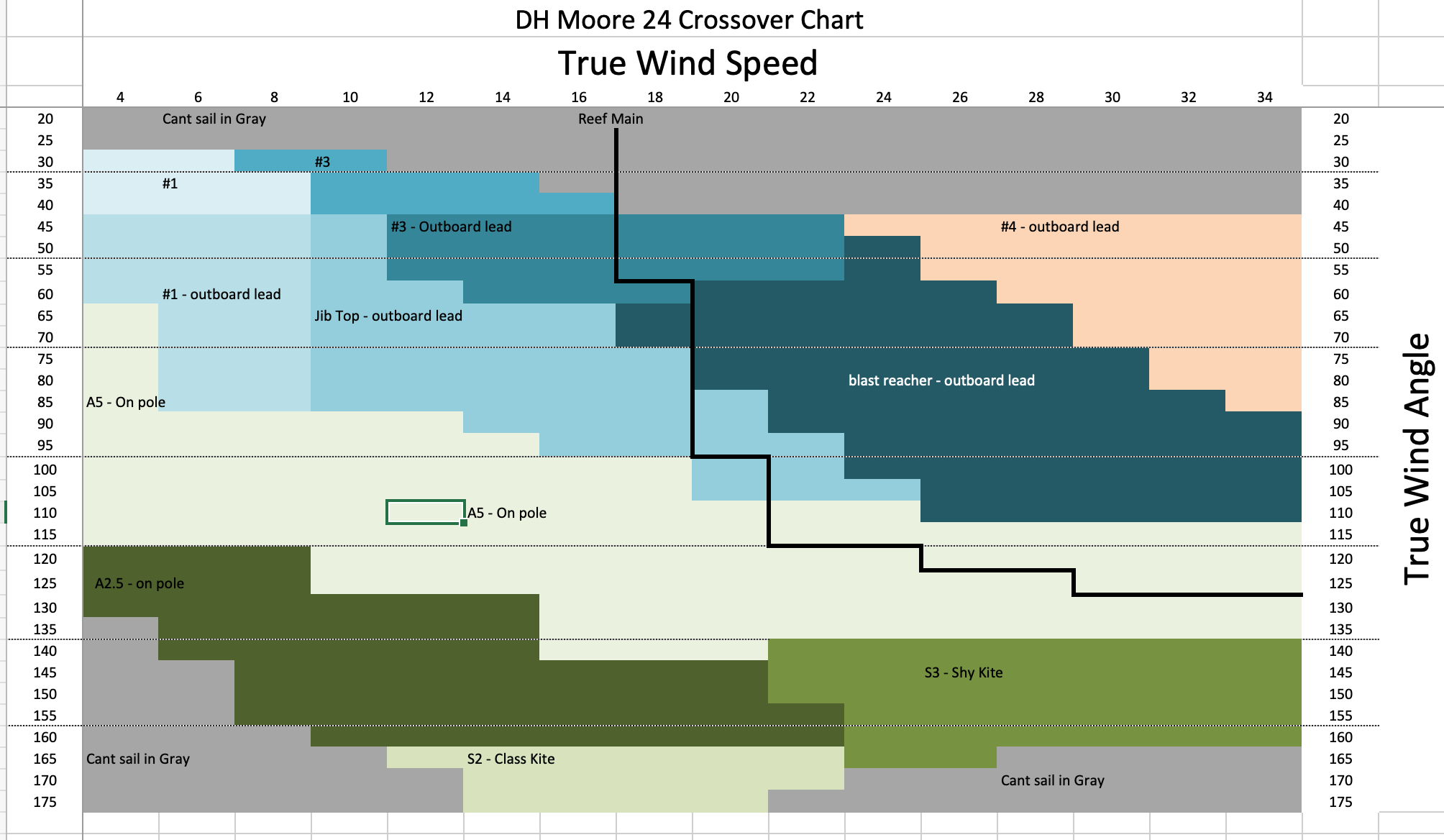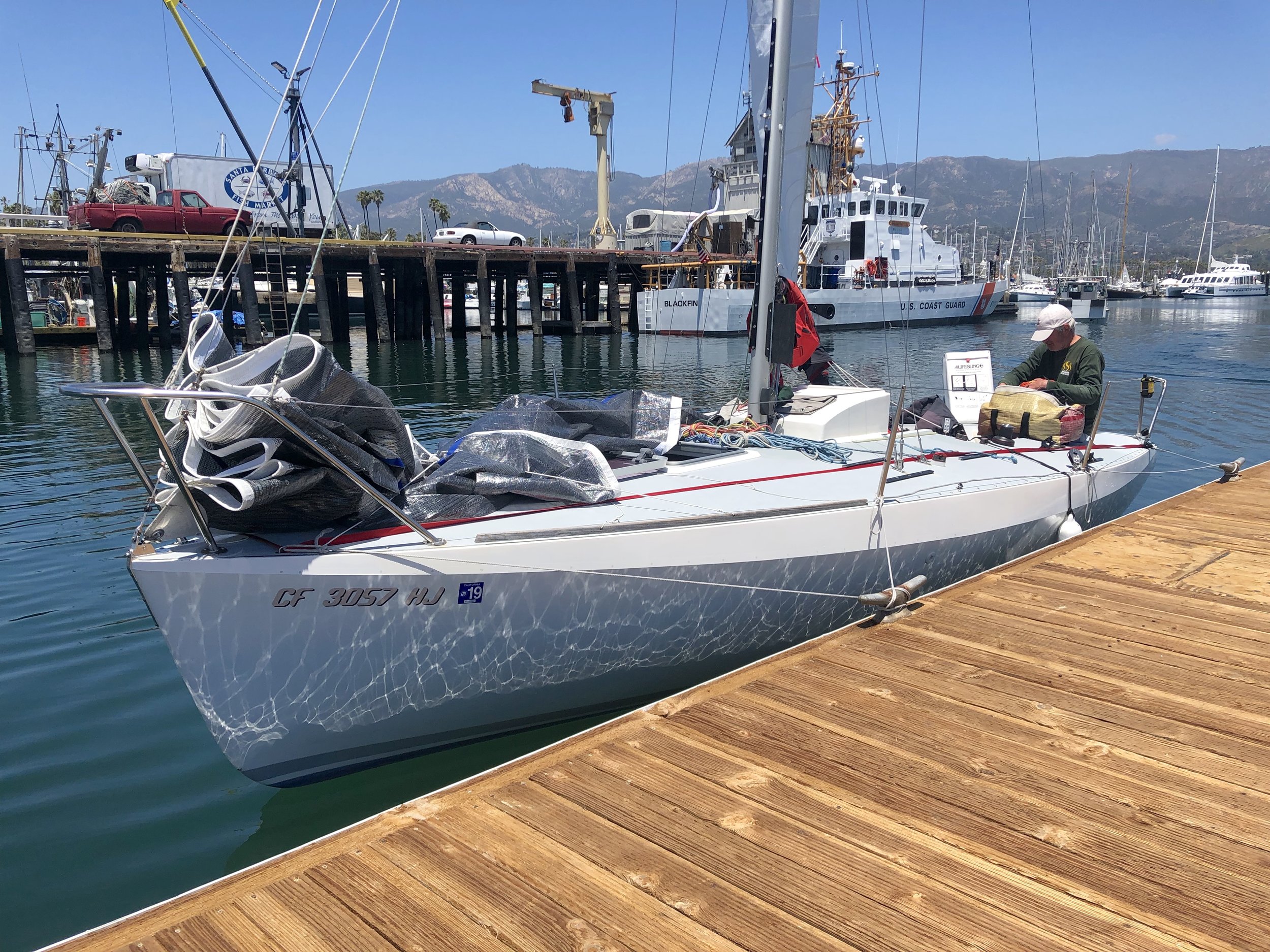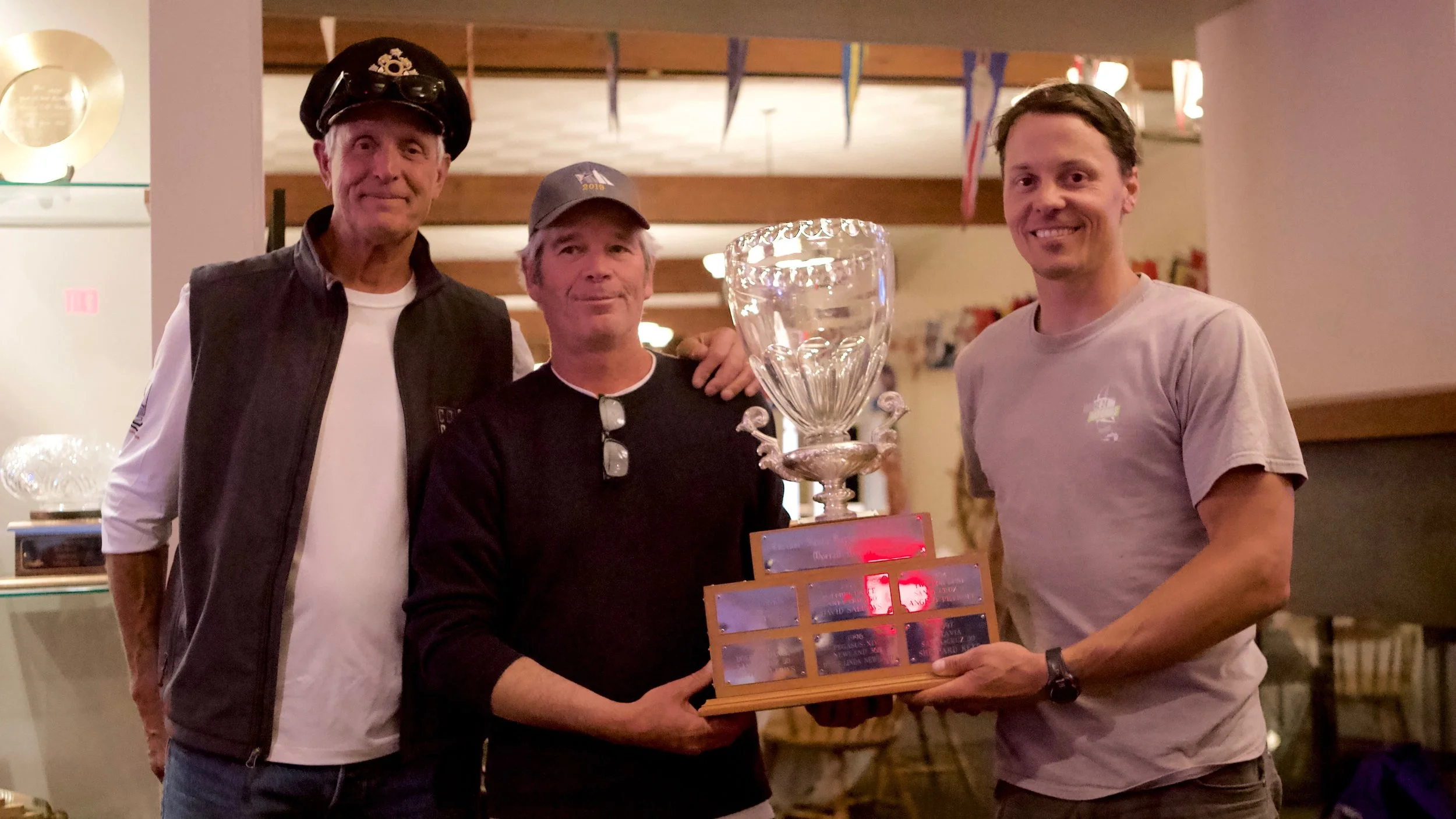I had some unsettled business with Coastal Cup after making landfall by air instead of water two years ago. Steve and I were ready to take another stab at it. Snafu has been equipped with a bomber Ballenger rig - the Express 27 section rather than Ultimate 20 section this time.
This year’s Coastal Cup was attended 18, mostly by big boats: an Australian RP66, two SC70’s, SC50’s Oaxaca & Deception, SC52 Lucky Duck, and a couple of Cal 40’s. Mostly Bay Area boats - a community we all know. The outliers were us as the lone Moore 24, and two Express 27’s: Tequila Mockingbird and Bombora. Unlike two years ago where they started us all in the same start (amusing!), the RC started the small boats first, and gave us a little gap to work with on our way upwind to Pt Pinos. They timed it perfectly: the first big boat to round, Lucky Duck, rounded just behind us, and rolled over us as we cracked off to a reach heading southwest. It was super fun having the big boats roll by rather than have them start 30 minutes ahead and never see them again.
We had a full arsenal of kites for this trip that Steve (Hogin Sails) made. The regular class runner kite, a shy kite (flatter, smaller), an A5 reacher and an A2.5 runner. Mas! had led the development of asymmetrical kites on Moores in the 2016 Pac Cup, and now a few of us have these kites.
Credit to Ian Rogers & Mark English from Mas! for the sail chart
Once rounded Pt Pinos, we cracked off the #1 and aimed directly for the next point of land: Cypress Point. The Expresses didn’t crack off. I suspect because they wanted to get height before setting their kites - or maybe they didn’t want the big boat dirty air. We bee-lined it and as soon as the wind backed to about 85 degrees true, we hoisted the A5 - breeze was still light. We may have only carried that sail for 30 minutes, but in that time, we scooted forward and rounded at Cypress point right along side the Expresses. With the wind backing, we set the A2.5. The Expresses set their symmetrical reachers. Yet It was night and day - the 2.5 is just fast. Bombora sailed high, Tequila sailed low closer to shore. They were separating and had to make a call on who to cover.
Check out those numbers. A2.5 sailing its optimal angle
We had downloaded GFS weather data for the course, and HRRR data for Monterey Bay and the Santa Barbara channel. I downloaded a last data set while we still had cell reception and sailing conditions were modest. The routing based on the HRRR data wanted us to jibe inshore for a geographical shift (that GFS did not see). I wasn’t keen on that. Not a fan of inshore waves - I just wanted the nice stuff further out. But I also didn’t see the value in going high - there wasn’t a pressure gradient out there to go for, it was all pretty uniform across the course.
|
|
Routing using HRRR data (left) vs GFS data (right)
Tequila seemed to be doing what we would do, so we stuck with them. The late afternoon was fun as the breeze built, at first lots of pumping to catch waves, and eventually freshened. It seemed that in the swell we were pretty on par with speed, surfing more easily. Matt on Tequila was in disbelief at how low we were able to sail. The breeze filled in the evening - absolutely glorious evening conditions.
Another major change this year was moving from Tacktick to B&G instruments. NMEA0183 to NMEA2000 - it’s just a world of difference with the faster data rates (10Hz vs 1Hz). We had one display giving us true wind angle and wind speed, the other SOG and heading. With a full sail chart, we know exactly what sails we should be in for the wind conditions, and we can sail extremely effectively by True Wind Angle. Not only does it eliminate the need to kink your neck every few seconds to glance up - having a numerical value for TWA really does allow you to sail a lot closer to the edge (e.g. >172deg TWA) when you want to. I find it really difficult to discern those nuances in TWA when you are looking at a Windex (apparent wind angle), so you probably end up sailing closer to 165 and won’t sail really any deeper down a wave. With a TWA readout, you know exactly where that line is. Pretty powerful. This is all standard stuff on big boats, just new to us small guys that usually sail by the seat of the pants.
The night came, we lost track of Tequila - they sailed a little higher and went further out. Bombora had jibed behind us and went closer to shore. My preference was to stay offshore in cleaner seas, though I’m not sure the inshore vs. offshore difference was as dramatic as it was last time.
The breeze held by the middle of the night was a solid 23 gusting to 28, 30 now and then. That is full on for doublehanding in big seas all night long without depowering. Last time I was at the climbing gym I did this route labeled 5.11b: Tripping on Cortisol. Most of the night felt that way to me, as I clenched my foul weather gear between my teeth as a mouthguard. Part of what was unanticipated was that we were supposed to be falling off the back of the pressure zone that was moving south. Instead we surfed our way to out-sailing our polars, and found ourselves well inside that pressure zone next time I re-ran a route.
Planned route. We caught up to the 25kt pressure zone and rode it south
Doublehanding a textbook Coastal Cup is tough. At night here’s just no backing off, no moment for a break - and we knew the competition was fierce. If there was a lull for a few minutes I could go sit down below, weight in the middle, and try to run a new route. We had to do this pretty often because we were blowing away our polars and constantly ahead of where we thought we should be.
Throughout the night we saw lights, heard chatter on 16 with racers coordinating with ship traffic. There was something eerie about the whole thing. A light appeared to port and slowly converged, passing in front of us. We weren’t sure what it was, but presumed it was a big boat - maybe one of the Cal 40’s. Green turned white then red as it moved over to the right into the distance.
Snafu, Bombora (green) and Tequila (orange) converged in a tight beeline
Steve and I had alternated driving, with stints ranging from 30 minutes to maybe 1.5 hours. I lost track of how many roundups we had, but probably 6 or so. There’s just something about these waters that feels BIG. Nervewracking. Like a Pac Cup squall that just keeps going. But the waves are sketchier. They knock you around. They’re breaking all around you. At 1:15am or so, we rounded up, and just like that, the squared back pole rotated aft, and snapped like a toothpick around the shroud. Not sure how that happened but I presume the foreguy came loose. We took the kite down, and pulled out the backup pole. It was a dented, crusty old thing, and didn’t have a foreguy bridal. We lost a few minutes there under main only, and decided to hoist the shy kite.
At 2am we heard the USCG announce a small craft advisory for the SB channel. Wait a minute! Our HRRR data for the channel shows 15 dying to 5kts and hot angles. We heard that announcement a few more times through the night. We knew we were going to have to improv the plan in the channel.
The breeze moderated, but running on the backup, we decided to wait until daylight before shifting back up to a full kite. We were a little frazzled and gun shy. As the early light arrived, we tried to figure out what boat that was to the right of us. With both waves on a crest the red hull was visible. The kite matched recollection too. Damn it’s Bombora! A2.5 time immediately. It was back to match racing and the entry strategy to the channel and the finish became clear: stay between them and the finish.
Rounding Conception was nothing short of glorious, alongside Bombora.
My recollection of Conception was that it was the gateway to Southern California. As soon as you round, the winds moderate, the waters become turquoise, layers come off, you sail hotter angles, maybe weight to leeward. Winds moderated to 15 or so and we did shed a layer. And then WHOOM. Back up into the 20’s and immediate wipeout. Back on our feet, back in full plane, and then more pressure. Like the hand of God pushing you from behind, gusting to 32kt. The small craft advisory as promised, cortisol levels rising again. I thought this was over!
Solid 13’s in the channel
Eventually, around 8am the winds moderated for real, and we threw in a couple of jibes to play the shifts and keep aiming at the finish. Bombora on our heels. We crossed the invisible line 11 miles from Santa Barbara just before 10am, and doused. Within minutes, the wind died fully, it seemed. We stopped to say hi to Rebecca, Julia, and Zac. They had beers, we did not. They tossed us a flask of whiskey that became the object of a laughable MOB drill and then motored back to SBYC in calm waters and no breeze. The rest of the fleet had some light air battles at the end.
We had no idea what our standings were. We knew that our routing had forecast us to finish in 24h 31m, and I had no expectation of being able to sail a perfect race - we anticipated 25-26 hours, maybe more. We finished in 21h 51m. During the couple of hours of the motor back, our results were posted. We corrected out first, Bombora 2nd overall. 52 minutes ahead of Velvet Hammer in 3rd place on corrected time; we set a corrected time course record in the process. There was a moment of celebration among these two bubbly groups of tired sailors.
No doubt the small boats sailed a great race, coming in hot right behind the SC50’s
SB harbor was full of sleds, staged for the SoCal300. Everyone onboard waved, and seemed to know the small boats as we motored in with our rattlecan outboards. The whole experience was pretty insane, and hanging out with all of the folks that sailed down the coast with you, on a sandy beach with a band and a drink in your hand is all pretty surreal.
Snafu in her happy place in Santa Barbara
Bombora drying out
Beachfront racing
Moore 24’s back on the Perpetual, alongside Mas!
The ORR-EZ misfits!
The small boats did really well this year. The Moores and Expresses were able to sail to their full potential - and surf. And surf. And surf. Wavefronts were going 13 knots. We heard from big boats saying they were just locked into a wave, going the same 13 knots we were doing on a plane. The best part of this was being in good company - having competitors in the same battle. More is only better.
The Coastal Cup experience is truly unique. It encompasses so many of the elements of an ocean race, in a (typically) nuclear 24 hour run. It’s not full on Pac Cup, but the closest thing to it, and a gem (is the analogy the K2?) of west coast sailing. It’s extraordinary to be able to compete against the big boat campaigns, on their turf, with relatively modest budgets. Do it.
Karl














